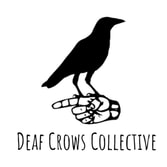For media interview requests please email: [email protected]
Media Interview Protocol
- All Deaf Crows performer(s) will attend interviews with an American Sign Language interpreter. The interpreters role is to interpret what is being said to the performer(s) and what he/she says back to the interviewer. ALL questions should be directed to the performer(s).
- The interpreter must be positioned beside the interviewer to allow for the performer(s) to see both the interviewer and the interpreter. The interpreter does not need to be on camera.
- Many of our performers are new English and/or ASL learners. In order to ensure a successful interview (especially in live situations), we ask for interview questions to be provided to our media team at least 48 hours in advance.
- Please refrain from using the term “Hearing Impaired”; this term is rejected by the Deaf community as it suggests the person has a defect needing repair. In our performers case the term ‘Deaf’ should be used unless the performer directs you otherwise.
- Deaf Crows Collective performers identify as culturally Deaf individuals. This means, in written material, please use “capital D” as an identity marker ie. Deaf as opposed to deaf. This marker is fully described by Carol Padden and Tom Humphries, in Deaf in America: Voices from a Culture (1988): We use the lowercase deaf when referring to the audiological condition of having a hearing loss, and the uppercase Deaf when referring to a particular group of Deaf people who share a language – American Sign Language (ASL) – and Deaf culture.
Additional Information
- American Sign language is not a universal language — each country has its own sign language, and regions have dialects, much like the many languages spoken all over the world. ASL is not simply signed English, but like any spoken language, is a refined and complex language with its own unique rules of grammar and syntax. Like all languages, ASL is a living language that grows and changes over time.

